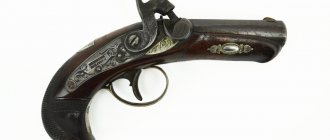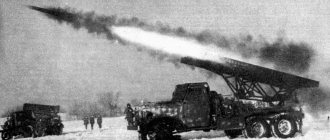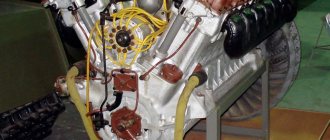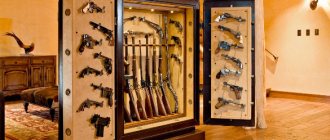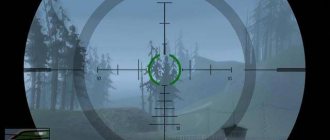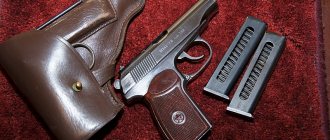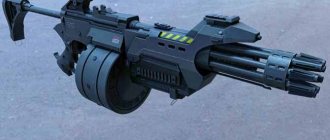Notes
- The writer and scientist I. Kh. Gamel in the book “Description of the Tula Arms Factory in Historical and Technical Relation” shows captain-lieutenant Albedil “in the artificial part”, and lieutenant Ovtsyn “in the economic part” since 1736, while the historian and Local historian I.F. Afremov in the book “Historical Description of the Tula Province” shows both of them as plant managers[14].
- There was a typo on page 200 of I.F. Afremov’s book. Prince Yegor Mikhailovich Nazarov was the last ruler from the treasury chamber since 1794
, and not since
1791
, as indicated in the book.
Sources
- OJSC "Tula Arms Plant". History of the enterprise.
- Chudnov Gabriel. Designer S.I. Mosin.
- Mikhailov V. S. Essays on the history of the military industry
- History of TOZ on its official website.
- Kuzminsky A.V.
Weapons for the hunter: a practical guide / ed. A.E. Taras. - M.: AST, 2002. p.152 - Nikolai Dergachev, Alexander Kudryashov. Three-line - more than a century in service // Caliber magazine No. 2, 2003.
- « 2.3.1.
Hunting firearm with a rifled barrel... Carbine KO-44 cal. 7.62x53; Carbine KO-44-1 cal. 7.62x53 "Order of the Government of the Russian Federation No. 1207-r dated August 3, 1996 "List of service and civilian weapons and ammunition included in the State Cadastre of service and civilian weapons" - Nikolai Dergachev, Alexander Kudryashov. KO-98M1 from the Mauser 98K family // Caliber magazine No. 12, 2002.
- Number test. Mauser KO 98 // Caliber magazine No. 1, 2001
- Guide to the collections of the State Archives of the Tula Region. Part I. Tula Arms Plant
- Changes in economic policy can be traced by the change in the name of the Tula Arms Plant
- Vadbolsky Nikita Matveevich
- I. H. Gamel.
Description of the Tula Arms Factory in historical and technical terms. - M.: Printing house of August Semyon, 1826. - P. 54 - I. F. Afremov.
Historical description of the Tula province. - M.: Printing house V. Gautier, 1850. - P. 190 - Vasily Fedorovich Pestrikov
- I. H. Gamel.
Description of the Tula Arms Factory in historical and technical terms. - M.: Printing house of August Semyon, 1826. - P. 56 - Semyon Nikiforovich Veniceev
- I. F. Afremov.
Historical description of the Tula province. - M.: Printing house V. Gautier, 1850. - P. 199 - I. F. Afremov.
Historical description of the Tula province. - M.: Printing house V. Gautier, 1850. - P. 200 - I. H. Gamel.
Description of the Tula Arms Factory in historical and technical terms. - M.: Printing house of August Semyon, 1826. - P. 67 - Months and general staff of the Russian Empire for 1837. Part I. Page. 161. - St. Petersburg: Imperial Academy of Sciences, 1837.
- The highest orders on military ranks. 1836, January-June. - St. Petersburg: Military Printing House, 1836.
- The highest orders on military ranks. 1837, January-June. - St. Petersburg: Military Printing House, 1837.
- E. E. Drozdova.
The numerical composition of the technical administration of the Tula arms factory in 1870-1917. Page 83. - Tula., magazine "News of Tula State University", 2009. - Nikolay Pavlovich Teplov
- 20s of the XX century. Collective management of TOZ. Rare photo.
- Reference book.
All Tula and Tula province. - Tula.: Publishing house of the Tula Provincial Executive Committee, 1925. - Ivan Abramovich Nevstruev
- 1906 - A. A. Tomilin was born
- Alexey Alekseevich Tomilin
- ↑ 12345
Directors of the Tula Arms Plant during the Great Patriotic War - Nikolai Dmitrievich Maslennikov
- Monument to Peter I
- Monument to S.I. Mosin
- Walk of Fame of famous gunsmiths of Tula
- Monument to Tula gunsmiths and soldiers of the First World War
- Monument to Tula gunsmiths and soldiers of the First World War
- Badge “250 years of the Tula Arms Plant”
- Token “250 years of the Tula Arms Plant”
- The procedure for presenting the anniversary medal “300th anniversary of the beginning of state arms production in Tula”
- Three rubles 2012 “300th anniversary of the beginning of state arms production in Tula”
- Three rubles 2012 “300th anniversary of the beginning of state arms production in Tula”
- Postal block “300 years of the Tula Arms Plant”
- Monument to Peter
- F. V. Tokarev
- S. A. Zybin
- Maxim machine gun
- Tokarev pistol and Nagant revolver
- Hunting rifles
- Postal card “250 years of the Tula Arms Plant”
- Streets with weapons names
Brand on edged weapons – Law Firm Vershina
McFarlane) “Bluebook of Identification of Reproduction Nazi Edged Weapons.”
You should also pay attention to the section on this topic in the book “Edged Weaponry of the Third Reich” by Major Jack Angolia. We will not list the specific features reflected in this type of research.
You can find them in the sources listed above. We provide only key recommendations that will help researchers and collectors make the right decision when purchasing or inspecting the next sample of edged weapons.
There can be nothing more valuable than your own experience gained through years of research and work. However, there are some basic signs of fakes that are understandable even to a layman.
A collector who has a list of such correspondences can easily avoid counterfeiting by making sure that the stamp affixed to the sample being studied is incorrect. For example, knowing the full list of companies that produced naval daggers for the needs of the Reich, it will be much easier to identify a fake.
7. False suspension. If the suspension doesn't match the model we're looking at, that's a good reason to raise our red flag. Despite the fact that pendants, cases and lanyards are often similar and can be used with different models of daggers, recently there has been a tendency to counterfeit them.
Manufacturers. main marks of manufacturers of the Third Reich
Therefore, modern collectors find individual copies containing a control number that cannot be identified precisely due to lost records and other adjustments made by the passage of time.
Peculiarities of marking by various organizations of Nazi Germany: some organizations, for example, the Nazi party school, the postal service and the German Red Cross, affixed their initials directly to the hilt of the weapon.
In the case of the DRK, the corresponding inscription was applied on the back of the dagger in the place where, on the front side, there was an image of a German eagle clutching the Red Cross emblem in its talons.
In contrast to this method of marking, organizations such as NSFK and DLV placed their emblem on the end of the dagger sheath. In rare cases, you can see two stamped emblems of these organizations on the same scabbard. The reasons for this should be sought in their history.
St. Petersburg knife club
- Technical marks.
- The heat numbers of the steel from which the blades were made were placed on the shank (stem) of the blade
On cavalry sabers of the 1927 model, produced in the 1930s, the stamps “18 kg”, “17 kg”, “16 kg”, “15 kg” were placed on the heel. They were evidence of determining the hardness of the blade steel, in kilograms per square centimeter, according to the Knoop method used at that time.
Important
In 1941, such marks were abolished. In 1939–1940, checkers were marked with a mark conventionally called a “snowflake” - *. Archival materials from the plant do not make it possible to determine its significance.
Attention
Probably, this mark should be attributed to the military. During the Soviet period, the system of technical control and military acceptance of weapons was preserved in its previous form. Therefore, the weapon branding system differed slightly from the pre-revolutionary one.
[1] JSC. F. R-303. Op. 1. D.
Military marks on Russian edged weapons
At the heel of the blade, the serial number of the dagger No. 000 001 is applied, and so on, on the inside, in the transverse direction.45. On all daggers that have passed the inspection of the military representative, on the guard, below under the flask, a personal mark or symbol of the military representative is placed.”
[7] At the same time, the marking of the naval cadet broadsword was carried out according to the technical conditions adopted on May 19, 1945, just like the 1927 model checkers. In the list of operations for making a broadsword, especially Fr.
Unlike the weapons of the ground forces, the branding of which was carried out using the impact method, the branding of naval weapons was carried out differently: “According to the technology for naval daggers and naval cadet broadswords, the operation of marking products on an electric engraving machine is established, for which tungsten steel needles are used.” .
Stamps of the main manufacturers of edged weapons of the 3rd Reich
The markings of the 1927 sample checkers remained the same, but the rules themselves were given in a slightly different edition: “On all valid accepted blades, stamps must be stamped: a) on the stem of the blade - the heat number; b) on the area near the stem of the blade, on one side - the brand factory and the year of manufacture, on the other hand - the stamp of the head of the quality control department, certifying the suitability of the blade; c) on the rings of the sheath and handle and tips - the stamps of the head of the quality control department; d) in addition to the indicated brands, on all products that have passed the inspection of the military representative, the personal stamp of the military representative is placed (about OTK stamps). [6] Marking of dirks was carried out somewhat differently. Let us quote the Technical Conditions for the manufacture and acceptance of a naval dirk, adopted on January 29, 1945: “44.
All valid, accepted blades must have stamps stamped on them: the heat number on the stem of the blade, as well as the quality control department stamp certifying the suitability of the blade (the letter “G” is placed). Dunzer, Solingen-Hohscheid Code - M7/34 Manufacturer - Rudolf C. Jacobs, Solingen-GrafrathM7h/34 Joh.
Cuno Konig, Solingen Code - M7/35 Manufacturer - WilhelmHalbach, SolingenM7h/35 Ernst Backhaus & Co., Kierspe-Bahnhof i. W. Code - M7/36 Manufacturer - E. & F.
Horster, SolingenM7h/36 Karl Schmitz, Solingen Code - M7/37Manufacturer - Robert Klaas, Solingen-Ohligs(1051)M7h/37 Walter Dammgen, Solingen Code - M7/38Manufacturer - PaulSeilheimer, SolingenM7h/38 Franz Buss, Solingen M7/39Franz Steinhoff , Solingen-WaldM7h/39 Karl Nouvertne, Solingen M7/40Hartkopf & Co., SolingenM7h/40 August Linder, Solingen Title German blades and marks Author ]Kulinsky A.N.
Marks of Zlatoust edged weapons of the Soviet period. 1919 – 1955
And sometimes one such catalog is worth several modern reference books. The second law of the collector concerns the choice of gun sellers.
Choose those you completely trust. The range of relationships that collectors develop with sellers both domestically and abroad is very wide and varies from goodwill to dishonesty, and even deception.
Fortunately, the circle of hopod weapon collectors is quite compact and any dishonest transactions in the Internet age instantly become the property of all interested parties.
The third law states that if we have even the slightest doubt about the authenticity of the weapon we are purchasing, we should immediately abandon this idea.
Especially often, such doubts arise immediately before or immediately after a purchase. Of course, it’s better that your intuition doesn’t let you down before you buy.
Brand on edged weapons
On the Gitperjugend knife there was a number directly above the RZM control mark, which indicated the territorial affiliation of the organization of which its owner was a member. Patent marks Many copies of German edged weapons contain the abbreviation Ges. Gesh. This is a shortened form of Geserzlich Gesehutzt, which literally translates to “protected by law.”
This mark was affixed either directly on the hilt of the dagger itself, or on the blade under the hilt, where the manufacturer’s mark was usually located.
These innovations may lie in the method of manufacturing the product, and in the special shape of individual parts of the dagger, etc. This mark indicates that the company received a patent for the production of this type of product.
As in modern manufacturing, the manufacturer cannot deviate from the standards introduced by the company or organization that owns the patent.
Marks on bladed weapons of the Third Reich
Table of correspondence of code numbers to the names of manufacturers. Drawings of stamps were made by the artist to preliminary determine the manufacturer; they may have variations and differ in detail from the images of the originals code - M7/1 Gebruder Christians, Christianswerk, Solingen M7h/1 E.
Steineshoff, Solingen code-M7/2 Manufacturer - Emil VoosWaffenfabrik, Solingen (1166) M7h/2 Ernst Bochem, Solingen-Weyer code - M7/3 Kuno Ritter, Solingen-Grafrath M7h/3 Ernst Wagener KG., Solingen code - M7/ 4 August Muler KG., Solingen-Merscheid M7h/4 Peter Prass, Solingen. Code - M7/5 Manufacturer - Carl JuliusKrebs, Solingen M7h/5 Gebr.
Tuckmann, Solingen-Merscheid Code - M7/6 Manufacturer - N.
Stamps on Russian edged weapons
At the end of December 1944, the chief technologist of plant No. 391 wrote to military representative Major Petrov: “The People's Commissariat of Ammunition approved a factory mark for ours.
The latter should be used by the plant's shops on all finished products from January 1, 1945, but due to production difficulties associated with the preparation of the trademark, the latter will be manufactured no earlier than February 1-2, 1945.
In this regard, I ask for your consent to accept finished products with a trademark valid until January 1, 1945, for a period until February 1, 1945.” [1] The “IMZ” brand, introduced in 1945, still misleads weapons experts. In some publications it is interpreted as “Izhevsk Mechanical Plant”.
Marks on edged weapons in France
Schaaff, Solingen M7/57 Peter Lungstrass, Solingen-Ohligs M7/58 Louis Perlmann, Solingen M7/59 Carl Lutters & Cie., Solingen Code - M7/60 Manufacturer - Gustav L. Koller, Solingen M7/61 Carl Tillmanns Sohne KG., Solingen M7/62 Friedr. Plucker Jr.
, Solingen-Grafrath M7/63 Herder & Engels, Solingen-Ohligs M7/64 Friedr. Geigis. Solingen-Foche M7/65 Karl Heidelberg, Solingen Code - M7/66 Manufacturer - Carl Eickhorn 1933-34 (941) Code - M7/66 Manufacturer - Carl Eickhorn 1934-35 (941) Code - M7/66 Manufacturer - Carl Eickhorn 1935-41
(941) Code - M7/66 Manufacturer - Carl Eickhorn 1935-41 (941) Code - M7/66 Manufacturer - Carl Eickhorn after 1941 (941) M7/67 Gottlieb Hammesfahr, Solingen-Foche Code - M7/68 Manufacturer - Tigerwerk, Lauterjung & Co., Solingen M7/69 HA Erbe AG.
, Schmalkalden M7/70 David Malsch, Steinbach M7/71 Hermann Hahn, Solingen-Wald M7/72 Karl Rob.
Source: https://kvirinal.ru/klejmo-na-holodnom-oruzhii/
Plant managers
- Volkonsky, Grigory Ivanovich (1712-1715)
- Bruce, Yakov Vilimovich (in 1715)
- Vadbolsky, Nikita Matveevich[12] (1715-1720)
- Volkonsky, Vasily Grigorievich (1720-1726)
- Svechin, Ivan Yakovlevich (1726-1727)
- Khomyakov, Kirill Ivanovich (1727-1731)
- Polovinkin, Makar Abrosimovich (1731-1735)
- Brianchaninov (1735-1736)
- Albedil and Ovtsyn[13][k 1] (1736-1737)
- Beer, Andreas Benediktovich (1737-1744)
- Pestrikov, Vasily Fedorovich[15] (1747-1755)
- Khomyakov, Fyodor Timofeevich (in 1755-1756)
- Bibikov, Ilya Alexandrovich (1756-1763)
- Zhukov, Afanasy Semyonovich[16] (1763—1782)
- Guryev, Gabriel Fedorovich (1782-1785)
- Veniceev, Semyon Nikiforovich[17] (1785-1794)
- Ostolopov, Vladimir Ivanovich (in 1794)
- Nazarov, Egor Mikhailovich[18][19][k 2] (1794-1796)
- Dolgorukov, Pyotr Petrovich (1796-1800)
- Ekelen, Fedor Andreevich (1800-1804)
- Schrader von Treileben[20] (in 1804)
- Chicherin, Vasily Nikolaevich (1804-1810)
- Voronov, Fedor Nikitich (1810-1817)
- Staden, Evstafiy Evstafievich (1817-1824)
- Filosofov, Alexander Bogdanovich (1825-1836)
- Ammosov, Nikolai Alekseevich[21] (April 1836[22] - January 1837[23])
- Sivers, Alexander Ivanovich (1837-1840)
- Lazarevich, Nikolai Ivanovich (1840-1847)
- Samson, German Romanovich (1847-1858)
- Standersheld, Karl Karlovich (1858-1869)
- Notbek, Vladimir Vasilievich (1870-1876)
- Bestuzhev-Ryumin, Vasily Nikolaevich (1876-1889)
- Druzhinin, Ivan Alexandrovich (from January to November 1889)
- Patrus, Ivan Ivanovich (1890-1892)
- Kun, Alexander Vladimirovich (1892-1915)
- Tretyakov, Pavel Petrovich (1915-1918)
- Kubasov, Alexander Alexandrovich - before the plant was renamed into the Board of the First Arms Plant of the GAU (until August 1918)[24]
- Gruev, Dmitry Semenovich - Chairman of the Board of the First Arms Plant of the State Autonomous University (since August 1918)
- Savitsky, Nikolai Vladimirovich (1920-1922)
- Teplov, Nikolai Pavlovich[25] (1922-1923)
- Grozdev-Tokarenko, Grigory Nikanorovich (1924—1926)[26][27]
- Nevstruev, Ivan Abramovich[28] (1927-1931, with a break in 1930)
- Melnikov-Egorov, Pavel Ustinovich (1931-1933)
- Vannikov, Boris Lvovich (1933-1936)
- Martynov, Nikolai Vasilievich (statesman) (1939-1940)
- Tomilin, Alexey Alekseevich - headed TOZ in 1940[29][30], director of the evacuated TOZ (plant No. 314) in Mednogorsk (1941-1943)[31]
- Rudnev, Konstantin Nikolaevich - director of the evacuated TOZ (plant No. 314) in Mednogorsk (1943-1947)[31]
- I.P. Ershov - temporarily acting director of TOZ (plant No. 536) in Tula (December 1941 - March 1942)[31]
- Agafonov, Boris Mikhailovich - director of TOZ (plant No. 536) in Tula (03/30/1942 - 09/18/1943)[31]
- Romanov, Dmitry Vasilievich - director of plant No. 536 in Tula (09/18/1943 - 06/24/1957)[31]
- Sabinin, Evgeniy Nikolaevich (1957-1979)
- Maslennikov, Nikolai Dmitrievich (1979-1998)[32]
What does the mark on the KHI cup holder mean?
“Kazakovskaya filigree” deserves special attention. The mark on the KHI glass holder honored the elegant, highly artistic products of the Kazakovsky Art Products Factory. In Rus', this was the first artel where filigree items were produced.
It is quite difficult to collect many other marks that were placed not only on glass holders, but also on other products reflecting folk art, customs and traditions of the Soviet people in a single catalogue. But nevertheless, this was done in the book “Gold and Silver Business of the 15-20th Century.” The author of the book was M. M. Postnikova-Loseva, who painstakingly, bit by bit, collected historical information. The book contains images, transcripts, and each stamp has a serial number.
Modern products
Military products
- Kalashnikov assault rifle AKS-74U
- anti-tank guided missile Konkurs-M,
- 40-mm modernized under-barrel grenade launcher GP-25,
- automatic grenade launcher complex A-91.
- Special automatic machine "Val"
- Special sniper rifle "Vintorez"
Civilian weapons
- single-barreled hunting rifles, including repeating (MC 20-01, TOZ-106, TOZ-194, TOZ-94, etc.) and self-loading (MC 21-12, TOZ-87, TOZ-88, TOZ-124)
- double-barreled hunting rifles (TOZ-BM, TOZ-34, TOZ-54, TOZ-120, TOZ-200, etc.)
- including combined: TOZ-134-20, etc.
- small-caliber sporting rifles: TOZ-8, TOZ-12, TOZ-61, etc.
- magazine and self-loading small-caliber hunting carbines (TOZ-78, TOZ-99, TOZ-122, etc.)
- conversion hunting weapons:
- KO-44 and KO-44-1 - conversion versions of the Mosin rifle[6][7],
- OP SKS and TOZ-97 "Arhar" - conversion versions of the SKS carbine
- KO-98, KO-98M1 - conversion versions of the Mauser 98k rifle[8][9].
- self-defense weapon: gas revolver TOZ-101 “Badger”, etc.
Brand on the cup holder
The most common were cup holders made of cupronickel, which had 2 types of marks: “MELCH” and “MNTs”. The first mark belongs to an earlier period and is abbreviated as cupronickel. Later, cupronickel became more widely used, and some alloys began to be supplemented with lead. Material containing lead was not suitable for food purposes. For the production of cup holders, spoons and other tableware, cupronickel, which contains lead in its pure form, was not used and was used only with silver plating. That is why the new “MNC” brand was introduced. The MNTs cup holder was distinguished by a stable matte shine, similar to silver. Three capital letters indicated the composition of the alloy - copper, nickel, zinc.
